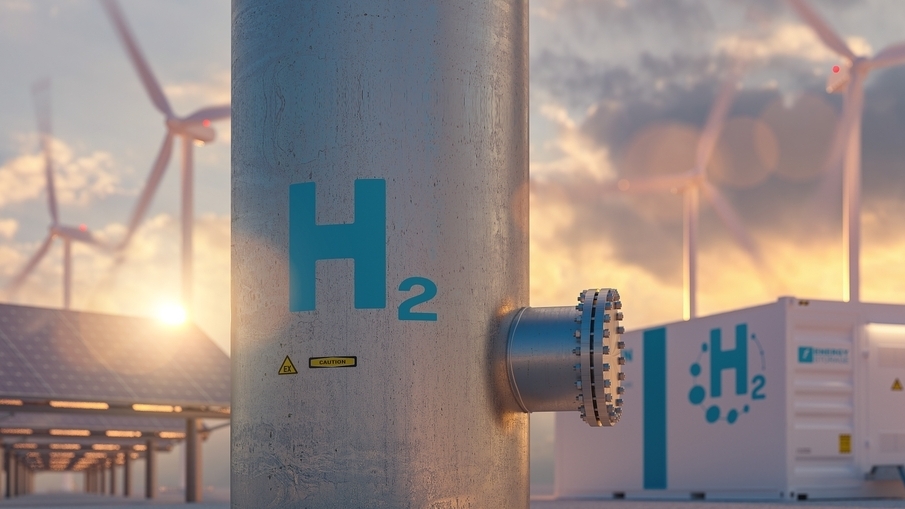
Green hydrogen: the ‘champagne’ of the energy transition?
As part of Net Zero Investor’s first instalment in a climate solutions series, Aysha Gilmore takes a deeper look at the case for investing in hydrogen
As investors become more focused on real-world decarbonisation and the need to move away from polluting fossil fuels intensifies, many asset owners’ interest in the newest and most investable climate technology has increased.
This has caused some investors to bet on one particular type of clean energy and technology– green hydrogen.
Green hydrogen backers, including governments, hope using renewable power to split water molecules can cut pollution by replacing 'grey hydrogen', or its derivatives methanol and ammonia, relied on by some of the biggest polluting industries including refining, heavy transport, steel and fertilisers.
By tackling and decarbonising these “hard to abate” sectors, such as steel production, some professionals believe that green hydrogen has the potential to reduce human-driven carbon emissions by more than 20%.
“Hydrogen is the champagne of the energy transition. To be used for the most difficult sectors and sparingly. The first thing we need to do is replace brown [or grey] hydrogen with green. There is a huge market of around 100m tonnes. Then we can do all the clever stuff,” Kingsmill Bond, energy strategist at the Rocky Mountain Institute, explained to Net Zero Investor.
Where is the interest?
Europe is generally seen as the leading industrial market or consumer of green hydrogen, with investor interest in the continent growing as a result of the EU’s Green Deal Industrial Plan. This has pledged subsidies and faster permits to ensure the region keeps pace in the green technology space.
For example, the Canada Pension Plan (CPP), which has CAD $576bn in assets, recently announced an initial €130m investment in the Dutch hydrogen project developer Power2X, acquiring a majority interest.
Power2X projects include ErasmoPower2X, a €1bn solar and hydrogen plant, and MadoquaPower2X, a €1bn industrial-scale hydrogen and green ammonia project.
“The European market is quite interesting because of an ability to develop projects close to the customers,” said Bill Rogers, managing director of sustainable energies group at CPP Investments, the investment arm of CPP.
In addition, €237.8bn Dutch pension fund PFZW and €456bn Netherlands-based fund ABP issued a €30m loan and €27m loan respectively to a Swedish firm H2 Green Steel for the construction of a hydrogen-powered steel plant in January.
The firm H2 Green Steel offers the first wide-scale application of green hydrogen in steel manufacturing, it has so far raised almost €6.5bn.
Other investors, such as Allianz Capital Partners have also committed to hydrogen, with the manager acquiring a minority stake in a Nordic independent developer of commercial-scale green hydrogen and green ammonia projects last year.
“Our investments in the green hydrogen and green ammonia plant developer Fuella in Norway, and the green hydrogen and power-to-gas developer Ren-Gas in Finland, fit perfectly with our energy transition infrastructure investment strategy and underline the importance we attribute to green molecules for the energy transition in Europe,” explains Igor Lukin, senior portfolio manager, infrastructure, at Allianz Capital Partners.
In the UK, £60bn Border to Coast Pension Partnership, Local Government Pension Scheme (LGPS) pool, invested €100m in a Clean Hydrogen Infrastructure Fund as part of a £1.3bn Climate Opportunities portfolio.
The Clean Hydrogen Infra Fund is managed by Hy24, which aims to have €20bn of investment capacity over the next six years. It is said to be the world’s first and largest infrastructure fund solely focused on investments across the clean hydrogen value chain, from production and conversion to storage, supply and usage.
Hydrogen is the champagne of the energy transition. To be used for the most difficult sectors and sparingly

Transport and aviation
Hy24 does not just invest in projects based around steel production, it also invests in hydrogen transportation systems, such as H2 mobility Deutschland, which operates and manages the +90 hydrogen filling stations across Germany for light to heavy vehicles and long-distance transport.
Aanand Venkatramanan, head of ETFs at LGIM, explains that the primary use case for hydrogen is tackling the hard to abate sectors, such as steel production, with mobility and transportation being second. LGIM launched the first pure Hydrogen Economy ETF in Europe back in 2021.
He told Net Zero Investor that the market for light, short-haul vehicles is dominated by BEV, with this unlikely to change over the next 20 years. However, hydrogen offers potential within industrial mobility.
“In the cases of long-range trucks, which in the case of batteries, they are not able to do thousands of miles, you would look at hydrogen based fuel solutions. This is the same for forklifts for instance.
“There is also hydrogen or ammonia powered shipping fuel. Those are kind of early days and this is the same for aviation as well,” Venkatramanan said.
Technology in this area, like most hydrogen projects, is fairly new. Truckmaker Tevva launched the first hydrogen fuel cell-supported heavy goods vehicles in 2022 whilst European vehicle manufacturer DAF is currently conducting trials with hydrogen-powered trucks.
Investors and governments have seen potential in these areas, with the UK Infrastructure Bank, a government-owned policy bank, allocating $40m to ZeroAvia, a British/American hydrogen-electric aircraft developer.
Nascent area
However, green hydrogen is “quite niche” and remains in the “fairly early stages” of development, with it being ten years behind the renewables sectors, Venkatramanan argues. Lukin suggests that “green molecules like green hydrogen are still being developed and can be compared to the renewables sector 15-20 years ago, which is mature today.”
Therefore, with all early-stage climate technology, there are associated risks and challenges.
Hydrogen suffers from “fairly primitive infrastructure” due to it being in the early stages of development Venkatramanan states. “Even when you look at battery electric vehicles (BEV), the charging infrastructure is still being built and it’s at least five years ahead of hydrogen,” he says.
Net Zero Investor's Nature Positive Investment Forum
24 April, London Stock Exchange sign up here
"It is essential for shareholders to be able to rely on robust evaluation systems that allow
Moreover, hydrogen has one of the lowest energy densities of any available fuel, which means storage and transportation can be a hurdle, it can also pose safety risks.
But, some such as Lukin suggest that hydrogen can be transported using already existing infrastructure “as it can use most modern gas distribution networks”.
For investors like £30bn UK defined contribution scheme Nest, the fund tends to prefer to focus on proven technologies and other energy transition infrastructure investments, such as car charge points, than emerging technologies.
“Hydrogen is often seen as a kind of holy grail for certain aspects of the energy transition, but the infrastructure is going to take a long time to develop,” said Katherina Lindmeier, senior responsible investment manager at Nest.
There are some good names and backers behind hydrogen, but the question is how we bring those small players and push them to become mid-cap and large-cap stock

Cost barriers
Investors also face cost barriers when it comes to green hydrogen as its production is quite expensive in terms of capex. Recent high inflation is increasing this challenge, with several hydrogen projects revising their initial cost estimates upwards by up to 50%, the International Energy Agency (IEA) reports.
“For investors like us that invest on behalf of Allianz and other pension funds and insurance companies, and seek opportunities with a lower risk profile it is hence a challenge to make such a project investable. Long-term offtake agreements for the commodity and so-called power purchase agreements for the main input factor green electricity can make the difference,” Lukin adds.
There is also a gap between the scale of electrolysis reserves operating and the scale of planned projects, “one cannot go without the other”, Lukin explains.
The IEA’s latest global hydrogen review also notes that announcements for new projects to produce low-emission hydrogen “keep growing”, but only 5% have taken firm investment decisions due to uncertainties around the “future evolution of demand, the lack of clarity about certification and regulation and the lack of infrastructure available to deliver hydrogen to end users”.
Better policy support
US and European governments through the Inflation Reduction Act, UK Low Carbon Hydrogen Business Model and the Green Deal Industrial Plan are making funding available to support the first large-scale green hydrogen projects. However, the slow implementation of these support schemes is delaying investment decisions.
Greater government action is key for opening investment in green hydrogen and overcoming barriers, particularly those around cost argues Venkatramanan.
“Better policy support being more transparent and consistent would definitely be welcome, particularly for fledgling industry.
“There are some good names and backers behind hydrogen, but the question is how we bring those small players and push them to become mid-cap and large-cap stock. You can only do this by incentivising the consumers, which can only be done through providing subsidies or making it cheaper,” he explains.
The IEA also remarks that governments “need stronger policy action on multiple fronts to tap into the opportunity that low-emission hydrogen offers”.




